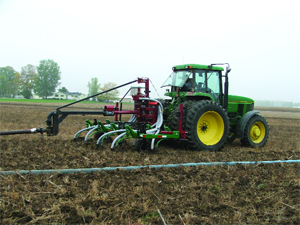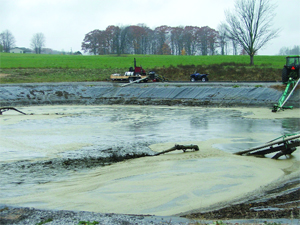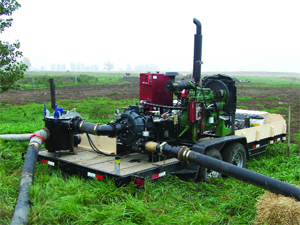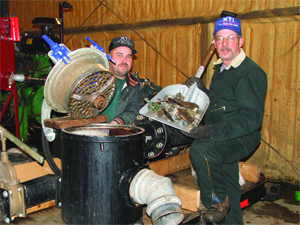
Custom manure applicator Dan Shaw is seeing the benefits of his company,
Mid-Thumb Irrigation, participating in a voluntary pilot project for
certification in Michigan, including the possibility of lower insurance
premiums.
Custom manure applicator Dan Shaw is seeing the benefits of his company,
Mid-Thumb Irrigation, participating in a voluntary pilot project for certification in Michigan, including the possibility of lower insurance premiums.
One of the byproducts of growth in dairy farming is increased volume of manure, and enterprising businessmen often notice this added production. And it’s clear that well-established proposals on how to deal with the added manure volume are key to a successful farming operation.
Veterans in the custom manure application industry like Dan Shaw know from experience that even in a competitive environment, it is important to always operate professionally to stay on good terms with the public. In an effort to raise the level of professionalism in the industry, Shaw was one of several custom manure applicators in Michigan who over the past three years participated in a voluntary pilot project. The project aimed to certify that personnel from participating companies were knowledgeable on a variety of subjects related to the safe application of manure on farmland.
The certification program was developed through a cooperative effort by manure application specialists at Michigan State University, the University of Wisconsin and the University of Illinois, and was offered to custom manure applicators in all three states.
Charles Gould, nutrient management educator with Michigan State University Extension, says the voluntary certification program resulted from some applicators running into problems with state regulatory agencies several years ago. “The applicators wanted to know how they could legitimize their businesses and help regulatory agencies, farmers, and the general public understand that they apply manure professionally,” says Gould.
Gould says that Shaw’s company, Mid-Thumb Irrigation Inc, has been a valuable addition to the program and rated the company as among the best in Michigan. “Dan uses the manure application plan of his farm customers, has modern equipment, has a spill response plan that he implements, if required, and knows the regulatory folks working in his area,” Gould says.
 Michigan’s Mid-Thumb Irrigation has designed a custom applicator system featuring a converted anhydrous ammonia fertilizer applicator frame, a Hydro Engineering manifold and a Krohn flow meter. Michigan’s Mid-Thumb Irrigation has designed a custom applicator system featuring a converted anhydrous ammonia fertilizer applicator frame, a Hydro Engineering manifold and a Krohn flow meter. |
The big pay-off for companies that have participated in the certification program is a significant reduction in their pollution insurance premiums. For example, during the first three years that the program was offered in neighboring Wisconsin, there were 80 percent fewer manure spill claims and applicators realized an average premium savings of $1,600.
Gould says his job now is to educate Michigan’s insurance carriers on the certification program’s benefits so that the state’s custom applicators can potentially get a break on their insurance premiums, as well. Shaw is hopeful that participation will eventually pay off.
Mid-Thumb Irrigation Inc, or MTI, is a manure management company located in the central thumb area of Michigan. It is headquartered about 50 miles east of Saginaw and was incorporated in 1985. It has evolved in many different directions since Shaw began the business with a single irrigation traveler manure application system 20 years ago. He started out farming but discovered that there were fewer worries carrying a debt load operating a custom manure application business than by trying to survive raising cash crops on the farm.
Shaw has always been an innovator, looking for better ways to maintain consistent production from his equipment while providing a quality application service to his customers. For example, earlier on he developed a hydraulically operated gun nozzle for his traveler irrigation system that he adapted for custom manure application. By powering the gun nozzle with hydraulics, he could maintain a good pattern regardless of the unpredictable consistency of the liquid manure from one location to another. Typically, an irrigation gun turns 180 degrees in one direction and then reverses, controlled by the pressure of the liquid pumped through the nozzle. However, Shaw quickly discovered that manure consistency had a big impact on broadcast performance. By operating the nozzle hydraulically, MTI achieved a more even broadcast pattern regardless of the manure consistency, even in windy conditions when operated at a lower pump pressure.
While good customer service is important, he knows that consistent cash flow is also critical when operating any business. So he has experimented with a variety of manure application approaches and equipment over the years. At present, he is using a drag hose system.
The application process all starts by stirring up the lagoon. Depending on its size, MTI uses two or three Houle agitators to break up any crust that has formed, mixing manure and bedding with the dirty water that has been pumped into the lagoon pit from the dairy operation. It is important to keep the pit stirred the entire time that it is being emptied to ensure that the fertilizer value from the applied manure is consistent across the field. A Cornell pump, powered by a stationary John Deere 185 horsepower stationary engine, pushes the manure through a six-inch diameter hose that extends in 660-foot sections to the field. In the field, the hose size drops to five inches and then to 4.5 inches, with the manure flowing into a manifold connected to the tractor, then through 2.5-inch diameter hoses into short tubes bolted behind the teeth of the toolbar.
The hoses used include a six-inch Angus main line, six-inch HilcoFlex, five-inch HilcoFlex and 4.5-inch Snap-tite.
The application rate is adjusted with pump pressure and tractor speed. A Krohn flow meter on the toolbar allows Shaw’s long-time applicator driver, Philip Schmitt, to monitor the flow. Once the flow rate is determined, a formula is used to calculate tractor speed for precise gallons per acre application. Nutrient samples from the manure—along with soil samples— determine the application rate, all according to the farmer’s comprehensive nutrient management plan.
Shaw was the first manure application business in Michigan to successfully tie two pumps together to maintain flow pressure so that the effluent could be pumped to fields further away from the barn. While there were many naysayers when he tried it for the first time, this practice is now commonly used by many existing custom manure applicators to pump manure several miles from the lagoon.
  Mid-Thumb Irrigation’s equipment set-up is designed for mobility. The trailer features the company’s John Deere stationary engine, Cornell pump and Vogelsang rock catcher. Mid-Thumb Irrigation’s equipment set-up is designed for mobility. The trailer features the company’s John Deere stationary engine, Cornell pump and Vogelsang rock catcher. |
Over the years, Shaw has learned what challenges can slow him down, and tries to address these and make the operation more efficient. The throttle speed on his second pump engine can now be radio remote-controlled so that a person doesn’t need to be standing right beside the engine to rev the engine up or throttle it down. His applicator operator can control the engine by remote control from the seat of the tractor.
Shaw has also invested in devices like a Vogelsang chopper and rock catcher in advance of his pump. “This virtually guarantees that there will be no plugging in the pump and in the line from the barn to the field,” he says. It also prevents rocks from entering the hose, thereby avoiding impeller and pump housing damage.
Shaw has experimented with a variety of equipment and toolbar designs. For example, he has taken an old anhydrous ammonia fertilizer applicator frame and adapted it for use as a manure injector, outfitting it with nine shanks from a used John Deere chisel plow, with the shanks spaced 22 inches apart. Previously, they were spaced 30 inches apart. Less distance between the shanks results in more even manure application. He also has splash pans that can be mounted on the front of the toolbar for immediate incorporation of the liquid manure for nutrient savings and odor control with little concern for run-off.
“By going with a bigger horsepower Cornell pump and a wider toolbar, we went from an average application rate of 800 gallons per minute to over 1,000 gallons a minute,” he says. “We are able to get things done a little quicker.” Shaw intends to add two shanks and extend his toolbar to 18 feet. A wider implement means fewer trips across the field and less wear and tear on the drag hose.
By creating an extremely portable manure management system, MTI has been able to pursue business as far as 175 miles away from home base. The toolbar implement is also versatile because by raising it slightly, Shaw is able to use it to apply manure to hay fields.
One interesting approach that contributes to the portability of the company’s equipment is that Shaw requires that his farm customers supply their own tractor. He says that about 95 percent of his potential customers are equipped with a farm tractor with adequate horsepower, and this helps him stay competitive on price. The farmer also supplies the fuel. “My farm customers would rather supply their own farm tractor than pay MTI to supply one,” says Shaw.
What makes the use of a variety of tractor models possible is his investment in a Hydro Engineering quick-to-quick manifold that not only provides him with the opportunity to connect to a variety of farm tractors, but also to a variety of toolbars. In addition to his custom designed toolbar, Shaw also uses an Aer-Way pasture rejuvenator implement on some jobs.
Shaw says it makes sense to follow Wisconsin’s lead regarding the certification program, since there are over 56 certified custom applicators in that state. In Michigan, about a dozen applicators have gone through Level I (that equates to about 99 percent of the known applicators in the state). Most of them have participated in some of the Level II training, but only Dan has completed Level III. There is a proposal to create a certification administration body that would serve Michigan, Indiana and Ohio, since those states have very few custom applicators as compared to Wisconsin.
 Mid-Thumb Irrigation owner, Dan Shaw (above, right), with assistance from equipment operator Philip Schmitt, shows some of the rocks and junk captured by the company’s Vogelsang rock catcher, installed in advance of their Cornell pump. Mid-Thumb Irrigation owner, Dan Shaw (above, right), with assistance from equipment operator Philip Schmitt, shows some of the rocks and junk captured by the company’s Vogelsang rock catcher, installed in advance of their Cornell pump.
|
Shaw says many of the concepts discussed during certification training are simply common sense practices that many conscientious applicators already practice in their day-to-day operations.
Level I pertains to all company employees involved in on-site manure application so that they have a basic understanding of manure application techniques, implementing a spill response plan, and awareness of state regulations. Level II focuses on crew supervisors and business owners. It provides them with a basic knowledge of how to apply the manure in an environmentally safe manner, ensuring that nutrient management regulations are met, and how to meet the farm customer’s expectation that the manure will be applied at the proper rate according to his management plan. Level III consists of companies putting together an Environmental Management Systems Plan. It is both a business plan and a manure spill response plan.
“I think our participation was worthwhile,” says Shaw. “It helped to bring to light some aspects of our business that we just took for granted in the past, like being more aware of environmental situations and taking preventative steps. We’re doing some things differently now than we did in the past.”